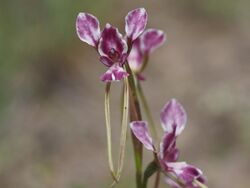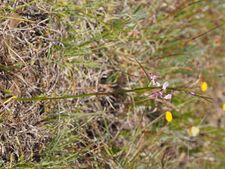Biology:Diuris dendrobioides
| Wedge diuris | |
|---|---|

| |
| Diuris dendrobioides growing near Invergowrie | |
| Scientific classification | |
| Kingdom: | Plantae |
| Clade: | Tracheophytes |
| Clade: | Angiosperms |
| Clade: | Monocots |
| Order: | Asparagales |
| Family: | Orchidaceae |
| Subfamily: | Orchidoideae |
| Tribe: | Diurideae |
| Genus: | Diuris |
| Species: | D. dendrobioides
|
| Binomial name | |
| Diuris dendrobioides Fitzg.
| |
Diuris dendrobioides, commonly known as the wedge diuris, is a species of orchid which is endemic to eastern Australia. It has one or two leaves and a flowering stem with up to six pale lilac-coloured to mauve flowers with darker markings.
Description
Diuris dendrobioides is a tuberous, perennial herb with one or two linear leaves 100–250 mm (4–10 in) long, 3–4 mm (0.1–0.2 in) wide and folded in half lengthwise. Between two and six pale lilac-coloured to mauve flowers with darker markings and 20–35 mm (0.8–1 in) wide are borne on a flowering stem 20–40 mm (0.8–2 in) high. The dorsal sepal is egg-shaped, 10–20 mm (0.4–0.8 in) long, 5–12 mm (0.2–0.5 in) wide angled upwards with curled edges. The lateral sepals are linear to lance-shaped, 35–65 mm (1–3 in) long, 1.5–3 mm (0.06–0.1 in) wide, and turn downwards. The petals are erect, ear-like above the flower, 7–13 mm (0.3–0.5 in) long and 5–9 mm (0.2–0.4 in) wide on a greenish purple, stalk-like "claw" 6–8 mm (0.2–0.3 in) long which gradually merges with the egg-shaped "ear". The labellum is 7–13 mm (0.3–0.5 in) long and has three lobes. The centre lobe is fan-shaped to almost circular, 6.5–11 mm (0.3–0.4 in) wide with a ridge along its mid-line. The lateral lobes are linear egg-shaped with the narrower end toward the base, 3–5 mm (0.1–0.2 in) long and 1–3 mm (0.04–0.1 in) wide. There are two broad ridge-like calli 3–6 mm (0.1–0.2 in) long either side of the central labellum ridge. Flowering occurs from September to January.[1][2]
Taxonomy and naming
Diuris dendrobioides was first formally described in 1882 by Robert FitzGerald from a specimen collected near Murrumburrah and the description was published in his book Australian Orchids.[3] The specific epithet (dendrobioides) refers to a resemblance of this orchid to a species of Dendrobium. The Latin ending -oides means "resembling" or "having the form of".[4][5]
This species is listed in the Index Kewensis as a synonym of Diuris punctata var. punctata.[6]
Distribution and habitat
The wedge diuris grows amongst grasses in forest. It is widespread in the eastern half of New South Wales but is rare in Victoria, occurring only near Wodonga.[1][2]
Conservation
Diuris dendrobioides is listed as "Endangered" in the Victorian Flora and Fauna Guarantee Act 1988.[2]
References
- ↑ 1.0 1.1 Jones, David L.; Weston, Peter H.; Orme, Andrew. "Diuris dendrobioides". Royal Botanic Garden Sydney: plantNET. http://plantnet.rbgsyd.nsw.gov.au/cgi-bin/NSWfl.pl?page=nswfl&lvl=sp&name=Diuris~dendrobioides. Retrieved 12 November 2017.
- ↑ 2.0 2.1 2.2 Jeanes, Jeff. "Diuris dendrobioides". Royal Botanic Gardens Victoria. https://vicflora.rbg.vic.gov.au/flora/taxon/297bcd14-c93a-46c1-bcdd-8a5106a002a0. Retrieved 30 November 2017.
- ↑ "Duiris dendrobioides". APNI. https://id.biodiversity.org.au/instance/apni/494124. Retrieved 30 November 2017.
- ↑ Brown, Roland Wilbur (1956). The Composition of Scientific Words. Washington, D.C.: Smithsonian Institution Press. p. 483.
- ↑ Jones, David L.; Egan, Jean; Wood, Tony (2008). Field guide to the orchids of the Australian Capital Territory. Canberra: National Parks Association of the ACT. pp. 114–115. ISBN 978-0980285420.
- ↑ "Diuris dendrobioides". World Checklist of Selected Plant Families (WCSP). Royal Botanic Gardens, Kew. http://wcsp.science.kew.org/namedetail.do?name_id=63393.
Wikidata ☰ Q65936865 entry


